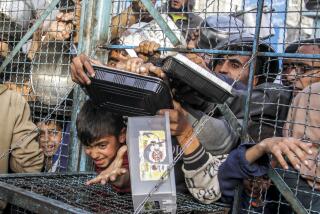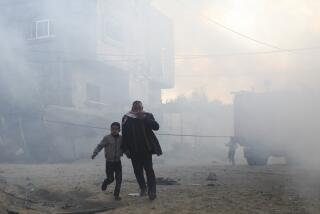Bombs hamper relief groups’ effort to beat the clock
(RealVideo and QuickTime)
PESHAWAR, Pakistan — The sweat-drenched crew loading sacks of grain onto Afghanistan-bound trucks here was working flat out earlier this week when the news came: U.S. bombs had dealt a glancing blow to the World Food Program’s main grain storage warehouse in Kabul, the Afghan capital.
Although the warehouse remained intact, doubts suddenly clouded the task at hand. The largest shipment of food in more than a year was being shipped to help millions of Afghans get through the oncoming winter without starving, but if storage facilities in Kabul weren’t safe, should the grain even go?
On Tuesday, a bomb struck the Kabul compound of the International Committee of the Red Cross, wounding one worker and setting two warehouses on fire.
Even before the United States and Britain began bombing Afghanistan on Oct. 7, the international relief community had faced huge challenges in its effort to stave off a humanitarian disaster there.
Now it’s facing a nightmare.
Getting food to an estimated 6 million people in danger of starving or going hungry is only one relief program hampered by the U.S. campaign against Afghanistan’s Taliban regime. Other efforts aimed at easing suffering in one of the world’s poorest, most fought-over lands, including health care, sanitation, water delivery and mine clearance projects, have all been drastically affected. Many programs have simply ground to a halt.
“Afghanistan is one of the toughest jobs we’ve ever had,” said World Food Program spokesman Michael Huggins. “Hundreds of thousands of people live in remote areas, we’ve got no communications with our staff, winter is on its way, and we’re racing against the clock to get food in there.”
Because of all this, World Food Program officials decided to keep loading after Monday’s bomb strike in Kabul. By early Tuesday, a convoy of about 60 trucks carrying enough wheat to feed 100,000 Afghans for a month had begun the perilous journey through the Khyber Pass to Kabul. For those involved in the intense international aid effort, there seemed little choice but to press ahead.
For some, there was an irony that the wheat that narrowly avoided destruction by a U.S. airstrike was itself American.
With only a few weeks before the first snows settle into the remote, drought-ravaged regions of northern Afghanistan, the World Food Program is desperately pushing grain into the beleaguered country.
The aid comes from staging points in Iran and Turkmenistan in the west and Tajikistan in the north as well as from Pakistan in the east. It all funnels into Kabul, which has the necessary storage facilities. Once it’s in the capital, privately funded aid groups distribute it to remoter areas of the country.
“We’re racing against the clock to reach those in the worst-affected northern provinces,” Huggins said. “If we’re lucky, winter will be late, and we’ll have six weeks. If we’re not, it could be only a month.”
For nearly half a million Afghans, the difference is critical.
The giant convoy that left here Tuesday was the third in the past 10 days to leave Peshawar for Kabul, but World Food Program officials admit that the pace simply isn’t fast enough.
“Conditions are tough,” Huggins said. “There just are not enough drivers available willing to make the trip.”
WFP officials say they now plan to supplement grain supplies with airdrops of so-called high-energy biscuits, but only once the U.S. air war ends.
But in the international aid community, airdrops are known to be the least efficient and most expensive way of getting food supplies to needy people -- almost 12 times as costly as taking food by truck. In Afghanistan, food drops also may fall into the many minefields left over from more than two decades of war.
In addition to the bombing campaign in Afghanistan, U.S. airplanes have been dropping high-calorie food packets into civilian areas. Aid workers contend that this effort is largely a public relations stunt and does very little to meet Afghanistan’s long-term food needs, and even the U.S. government admits it’s a stopgap measure.
Fazel Karim Fazel, who directs a mine-clearing operation inside Afghanistan, said some of his 120 workers have found the food packets in areas still implanted with explosives.
“Our concern,” Fazel said, “is that these refugees who have been walking for many days will become very hungry. In their rush to get food, they might come across a minefield.”
Aid distribution inside Afghanistan is also seriously hampered by a shortage of trained workers.
Within a few days of the Sept. 11 terrorist attacks in the United States, foreign staff directing aid efforts left Afghanistan for neighboring Pakistan. CARE International, which had a staff of more than 450 in Afghanistan at the start of last month and supported a variety of projects, including water distribution, road building and education, has pared down to fewer than 20 and keeps just one project going -- a water delivery network in Kabul that is the only source of water for 35,000 of the city’s residents.
“If we stop this project, people will die,” said Mohammed Halim Fidai, a CARE official in Peshawar.
For most aid organizations, communications with local staff members still inside Afghanistan all but ended with the Taliban’s edict a few days after the U.S. airstrikes began that anyone caught using a satellite telephone would be executed on the spot. With land telephone lines sparse and unreliable, the ban has in effect cut off the struggling local staff from their supervisors in Pakistan.
Those working under a United Nations-sponsored program to clear land mines from the country decided to continue their work despite the air campaign, arguing that it was too important to suspend. They reportedly even passed the map coordinates of their offices up the U.N. hierarchy so that the world body could ask the Pentagon to avoid the buildings.
Those protective measures weren’t enough: Four employees of the mine-clearing Afghan Technical Consultancy died instantly after their offices were mistakenly struck by a bomb last week.
There are other problems.
Riots in Pakistan sparked by the air campaign have turned the blue-and-white U.N. emblem into a target for protesters lashing out at any symbol of the West. In the western Pakistani city of Quetta, a bastion of pro-Taliban sentiment, demonstrators last week set fire to a UNICEF office and broke windows at a U.N. refugee agency office.
About the same time, Taliban supporters inside Afghanistan attacked employees of the U.N.-affiliated mine-clearance program.
In a sign of the times, World Food Program truck convoys inside Afghanistan quietly put away the U.N. flags that in more normal times serve as a protective emblem.
More to Read
Sign up for Essential California
The most important California stories and recommendations in your inbox every morning.
You may occasionally receive promotional content from the Los Angeles Times.











